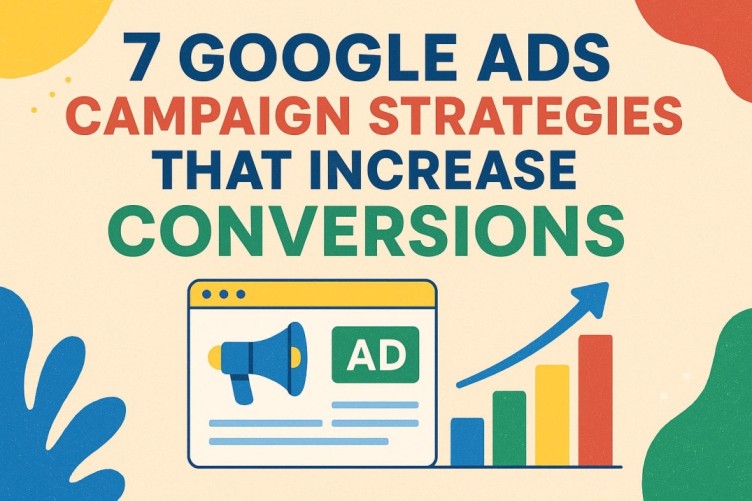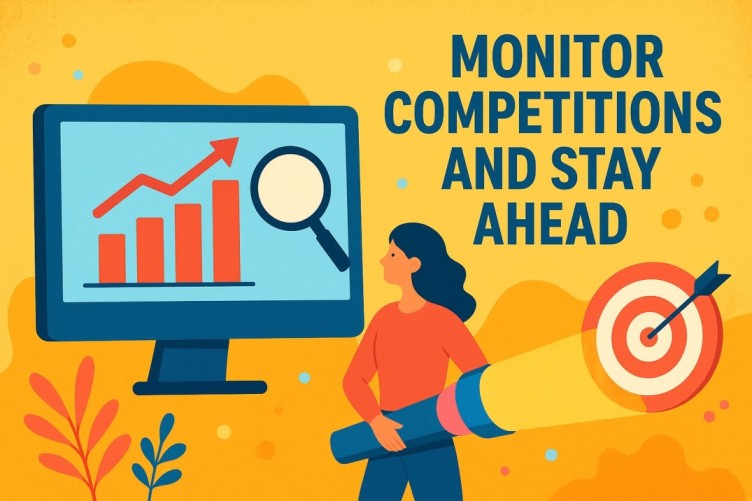7 Google Ads Campaign Strategies That Increase Conversions in 2025

Increase conversions in 2025 with these 7 proven Google Ads Campaign strategies. Boost clicks, leads & ROI with high-intent keywords & smart targeting.
In 2025, running a successful Google Ads Campaign is not just about spending more money—it’s about being smart, strategic, and focused on conversions. Many businesses waste a huge part of their budget on campaigns that don’t convert. If you want to grow your business fast, these 7 Google Ads strategies will help you get better results and more sales.
This guide is simple, actionable, and step-by-step, so even beginners can follow it easily.
1. Choose the Right Keywords for Your Google Ads Campaign
Keywords are the foundation of every Google Ads Campaign. Using the right keywords can make or break your campaign.
- High-intent keywords: These are search terms that show the user is ready to buy. For example, “buy leather shoes online” instead of “shoes.”
- Long-tail keywords: They are specific, lower competition, and often cheaper. Example: “best waterproof running shoes for men.”
- Negative keywords: These prevent your ad from showing for irrelevant searches. For example, if you sell premium shoes, use “cheap” as a negative keyword.
Tip: Regularly check your search terms report to refine keywords and save money on irrelevant clicks.
Why it matters: A well-chosen set of keywords ensures your Google Ads Campaign reaches people who are actually interested in your product or service.
2. Use Smart Bidding to Maximize Conversions
Bidding strategies are crucial for a profitable Google Ads Campaign. Smart bidding uses Google’s AI to automatically adjust your bids based on user behavior.
Key Smart Bidding Strategies:
- Target CPA (Cost per Acquisition): Helps you get more conversions at your preferred cost.
- Maximize Conversions: Google automatically spends your budget to get the most conversions.
- Target ROAS (Return on Ad Spend): Perfect for e-commerce stores aiming for a specific revenue goal.
Pro Tip: Start with Maximize Conversions to gather data, then switch to Target CPA once you know your conversion rates.
Smart bidding ensures that your Google Ads Campaign doesn’t just get clicks—it gets valuable leads and sales.
3. Write Engaging Ad Copy for Higher Click-Through Rates
Even the best Google Ads Campaign can fail if the ad copy is weak. Your ad needs to catch attention and persuade users to click.
- Use strong headlines: Make them catchy and relevant. Example: “Get 50% Off Today Only!”
- Include your focus keyword naturally in the ad copy.
- Use clear Call-to-Actions (CTA): Words like “Buy Now,” “Sign Up,” or “Get Started” work best.
- Highlight benefits, not just features: Instead of “Fast Shoes,” say “Run Faster & Feel Comfortable.”
Tip: Test different versions of your ad copy (A/B testing) to see which one gets more clicks and conversions.
A well-written ad makes your Google Ads Campaign more effective, increasing both clicks and conversions.
4. Use Ad Extensions to Boost Visibility
Ad extensions are free tools that make your Google Ads Campaign bigger and more informative on search results.
Popular Ad Extensions:
- Sitelink Extensions: Direct users to specific pages on your website.
- Call Extensions: Make it easy for users to call you directly from the ad.
- Location Extensions: Show your physical business location.
- Price Extensions: Highlight product pricing in the ad itself.
Why use extensions? Ads with extensions get higher click-through rates because they provide extra information and multiple ways to interact.
5. Target the Right Audience
Targeting is one of the most important strategies for a successful Google Ads Campaign. Reaching the right people saves money and increases conversions.
How to Target Effectively:
- Demographics: Age, gender, household income, etc.
- Location: Target areas where your customers live or where your services are available.
- Interests & Behaviors: Google allows targeting based on users’ online behavior.
- Remarketing: Show ads to people who visited your website but didn’t purchase.
Pro Tip: Create separate campaigns for different audience segments. This helps you tailor your ads for each group and improve conversion rates.
6. Optimize Your Landing Page for Conversions
Your Google Ads Campaign can attract thousands of clicks, but if your landing page isn’t optimized, most visitors will leave without converting.
Landing Page Tips:
- Match your ad copy with the landing page message.
- Ensure fast loading speed, especially on mobile.
- Include a clear call-to-action (CTA) above the fold.
- Keep the design simple and distraction-free.
- Use testimonials or reviews for social proof.
Pro Tip: Even small changes on your landing page, like changing a button color or adding a trust badge, can increase conversions significantly.
7. Analyze, Test, and Optimize Your Campaign
A successful Google Ads Campaign requires ongoing analysis and optimization. The best campaigns are never “set and forget.”
Steps for Optimization:
- Monitor Performance Metrics: Keep track of CTR (click-through rate), conversion rate, and cost per conversion.
- A/B Testing Ads: Test multiple versions of headlines, descriptions, and CTAs to find the best performers.
- Use Negative Keywords: Remove irrelevant searches to save money.
- Adjust Bidding Strategies: Based on performance, change from Maximize Conversions to Target CPA or vice versa.
- Refine Audience Targeting: Stop wasting money on segments that don’t convert.
Tip: Make small, consistent improvements to your campaign. Over time, these optimizations can double or triple your conversion rate.
8. Leverage Remarketing for Higher Conversions
Remarketing is showing ads to people who already interacted with your business. It’s one of the most effective strategies for any Google Ads Campaign.
- People who visit your website but don’t buy are more likely to convert on their second or third visit.
- Use dynamic remarketing ads for products or services users viewed on your website.
- Combine remarketing with special offers, discounts, or limited-time deals to boost conversions.
Pro Tip: Segment your audience for remarketing based on their actions—those who added to cart, downloaded a guide, or visited a pricing page should get different ads.
9. Use Ad Scheduling to Reach Your Audience at the Right Time
Not all hours or days perform equally in a Google Ads Campaign. Ad scheduling helps you show ads only when your audience is most likely to convert.
Benefits of Ad Scheduling:
- Save money by avoiding low-converting hours.
- Increase conversions by targeting high-traffic periods.
- Optimize bidding during peak times.
Pro Tip: Analyze historical data to find the days and hours your audience is most active. For example, e-commerce stores often see higher conversions in the evening and weekends.
Using ad scheduling ensures your Google Ads Campaign reaches the right people at the right time, improving ROI.
10. Take Advantage of Audience Insights and Custom Segments
Google provides advanced audience insights for advertisers. A well-targeted Google Ads Campaign uses this data to reach potential customers more effectively.
How to Use Audience Insights:
- Affinity Audiences: People interested in topics related to your business.
- In-Market Audiences: People actively searching for products or services like yours.
- Custom Intent Audiences: Create audiences based on keywords, URLs, or apps your potential customers interact with.
- Similar Audiences: Target users similar to your existing customers.
Tip: Combining audience insights with high-intent keywords allows your Google Ads Campaign to reach people who are ready to buy, not just browsing.
11. Leverage Video and Display Ads
While search ads are great for conversions, display and video ads help increase awareness and retarget potential customers.
- YouTube Ads: Showcase your product in action or explain benefits visually.
- Display Network: Show banner ads on relevant websites.
- Remarketing Display Ads: Remind visitors of products they viewed but didn’t buy.
Pro Tip: Video and display ads work best for remarketing. Users already familiar with your brand are more likely to convert when they see your ad again.
Using a mix of search, display, and video ads strengthens your Google Ads Campaign and increases conversions at multiple touchpoints.
12. Monitor Competitors and Stay Ahead

A smart Google Ads Campaign keeps an eye on what competitors are doing. Understanding their strategy helps you adjust your bids, ad copy, and targeting.
Competitive Analysis Tips:
- Use tools like SEMRush, SpyFu, or Ahrefs to see competitor keywords.
- Identify gaps in their ads you can exploit.
- Focus on areas where competitors spend less for higher ROI.
Pro Tip: Competitor monitoring helps you stay relevant, improve ad quality, and reduce wasted spend.
13. Invest in Mobile Optimization
Most searches in 2025 happen on mobile devices. If your landing page isn’t mobile-friendly, your Google Ads Campaign will lose conversions.
Mobile Optimization Checklist:
- Fast loading speed (under 3 seconds).
- Clear and clickable buttons.
- Minimal text and easy-to-read font.
- Optimized forms with fewer fields.
Tip: Test your ads and landing pages on different devices to ensure a seamless experience. A mobile-optimized campaign converts better and improves Quality Score, reducing costs.
14. Track Conversions with Proper Tools
A Google Ads Campaign is only effective if you track conversions properly. Without tracking, you won’t know which ads bring results.
Essential Tracking Tools:
- Google Ads Conversion Tracking: Track sales, leads, or sign-ups.
- Google Analytics: Understand user behavior and attribution.
- Call Tracking: Measure calls generated from ads.
Pro Tip: Always define what counts as a conversion before running your campaign. This ensures you optimize campaigns based on actual results.
15. Experiment with New Ad Formats
Google regularly releases new ad formats. Testing these can give your Google Ads Campaign an edge over competitors.
- Responsive Search Ads (RSA): Automatically adjusts headlines and descriptions to match search queries.
- Performance Max Campaigns: Uses AI to deliver ads across all Google networks.
- Discovery Ads: Reach users on Gmail, YouTube, and Discover feed.
Tip: Experiment gradually and track which ad formats bring the highest conversions for your business.
16. Focus on Quality Score for Lower Costs
Quality Score is Google’s way of measuring ad relevance, CTR, and landing page experience. Higher scores mean:
- Lower cost-per-click (CPC).
- Better ad positioning.
- Higher ROI for your Google Ads Campaign.
How to Improve Quality Score:
- Use relevant keywords in your ad copy.
- Ensure ad copy matches the landing page content.
- Optimize landing page speed and mobile usability.
Pro Tip: A high Quality Score lets you get more conversions at a lower cost.
17. Use Analytics to Make Data-Driven Decisions
The most successful Google Ads Campaigns rely on data, not guesswork.
- Track CTR, conversion rate, bounce rate, and cost per conversion.
- Identify which ads, keywords, and audiences perform best.
- Stop campaigns or ads that don’t deliver results.
Tip: Regularly analyze data and make adjustments. Even small changes can significantly improve your ROI.
Bonus Tips for a High-Converting Google Ads Campaign in 2025
- Use Countdown Timers: Highlight limited-time offers in ads and landing pages.
- Leverage Social Proof: Display reviews, ratings, or testimonials.
- Simplify Forms: Reduce fields to make lead generation easier.
- Test New Locations: Expand your targeting to new cities or regions.
- Stay Updated: Google frequently updates features, so keep learning.
Conclusion
Running a Google Ads Campaign in 2025 requires strategy, testing, and continuous optimization. By focusing on high-intent keywords, smart bidding, compelling ad copy, audience targeting, remarketing, mobile optimization, and conversion tracking, you can dramatically improve your conversions and ROI.
Remember:
- A strong Google Ads Campaign combines data, creativity, and audience understanding.
- Small improvements in ads, landing pages, or targeting can multiply results.
- Stay updated with Google’s latest tools and trends to stay ahead of competitors.
Start implementing these strategies today and watch your Google Ads Campaign deliver more clicks, leads, and sales than ever before!
Pingback: Social Media Ads in 2025: How to Run Profitable Campaigns on Facebook, Instagram & Beyond - auraclix